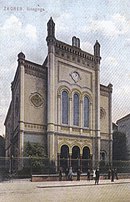The Judaism PortalJudaism (Hebrew: יַהֲדוּת Yahăḏūṯ) is an Abrahamic, monotheistic, and ethnic religion, comprises the collective spiritual, cultural, and legal traditions of the Jewish people. Contemporary Judaism having originated as an organized religion in the Middle East during the Bronze Age, and evolved from Yahwism around the 6th/5th century BCE, and is thus considered to be one of the oldest monotheistic religions.[improper synthesis?] Along with Samaritanism, to which it is closely related, Judaism is one of the two oldest Abrahamic religions. Religious Jews regard Judaism as their means of observing the Mosaic covenant, which was established between God and the Israelites, their ancestors. Jewish religious doctrine encompasses a wide body of texts, practices, theological positions, and forms of organization. Among Judaism's core texts is the Torah, the first five books of the Hebrew Bible, a collection of ancient Hebrew scriptures. The Tanakh, known in English as the Hebrew Bible, is also referred to as the "Old Testament" in Christianity. In addition to the original written scripture, the supplemental Oral Torah is represented by later texts, such as the Midrash and the Talmud. The Hebrew-language word torah can mean "teaching", "law", or "instruction", although "Torah" can also be used as a general term that refers to any Jewish text that expands or elaborates on the original Five Books of Moses. Representing the core of the Jewish spiritual and religious tradition, the Torah is a term and a set of teachings that are explicitly self-positioned as encompassing at least seventy, and potentially infinite, facets and interpretations. Judaism's texts, traditions, and values strongly influenced later Abrahamic religions, including Christianity and Islam. Hebraism, like Hellenism, played a seminal role in the formation of Western civilization through its impact as a core background element of Early Christianity. (Full article...) Selected ArticleJoseph's Tomb is a funerary monument located at the eastern entrance to the valley that separates Mounts Gerizim and Ebal, on the outskirts of the West Bank city of Nablus, near the site of Shechem. Biblical tradition identifies the general area of Shechem as the resting-place of Joseph and his two sons Ephraim and Manasseh. Joseph's tomb has been venerated throughout the ages by Jews, Christians and Muslims. Post-biblical records about the Tomb's location at this site date from the 4th century. The present structure, a small rectangular room with a cenotaph, dates from 1868. Modern scholarship has yet to determine if the cenotaph is the ancient biblical gravesite. No sources prior to the 5th century mention the tomb, and the structure originally erected over it appears to have been built by the Samaritans. Joseph's Tomb has witnessed intense sectarian conflict. Samaritans and Christians disputing access and title to the site in the early Byzantine period often clashed violently. After Israel captured the West Bank in 1967, conflict from competing Jewish and Muslim claims over the tomb became frequent. Though under the jurisdiction of the Palestinian National Authority after the signing of the Oslo Accords, it remained under IDF guard with Muslims prohibited. At the beginning of the Al-Aqsa Intifada in 2000, just after being handed over to the PNA, it was looted and razed by a Palestinian mob. Following Israel's reoccupation of Nablus in the 2002 Operation Defensive Shield, Jewish groups returned there intermittently. Recently the structure has been refurbished, with a new cupola installed, and visits by Jewish worshipers have resumed. (Read more...) Did You Know?Did you know...
Related Categories
Featured Articles
Related PortalsHistory ArticleThe Zagreb Synagogue was the main place of worship for the Jewish community of Zagreb in modern-day Croatia, from its construction in 1867 in the Kingdom of Croatia-Slavonia within the Austrian Empire, until its demolition by the fascist authorities in 1941 in the Axis-aligned Independent State of Croatia. The Moorish Revival synagogue was located on modern-day Praška Street and has been the only purpose-built Jewish house of worship in the history of the city. It was one of the city's most prominent public buildings, as well as one of the most esteemed examples of synagogue architecture in the region. Since the 1980s, plans have been made to rebuild the synagogue in its original location, but due to various political circumstances, very limited progress has been made. The current major disagreements which inhibit the construction of a new synagogue concern the involvement of Jewish organizations in the reconstruction and the design and character of the new building. (Read more...) Picture of the WeekIn the News
Featured Quote
WikiProjectsThings You Can Do
Weekly Torah Portion
TopicsAssociated WikimediaThe following Wikimedia Foundation sister projects provide more on this subject:
Discover Wikipedia using portals | |||||||||



























